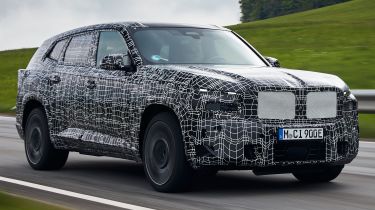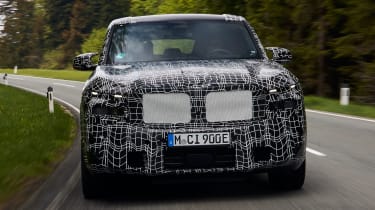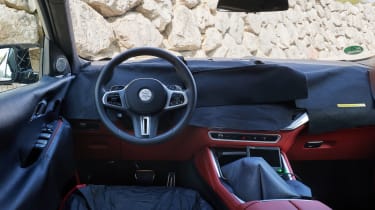BMW XM prototype review
The first bespoke BMW M car since the M1 supercar will be a whopper of a plug-in hybrid SUV, and we’ve driven it in pre-production form

Pros
- Plug-in hybrid powertrain
- Handles well
- Cabin space
Cons
- Firm ride
- Not as quick as expected
- Not the most engaging M car
| Car type | Electric range | 0-62mph | Fuel economy |
|---|---|---|---|
| Plug-in hybrid | 50 miles | c.five seconds | TBC |
BMW’s M division has churned out some of the most iconic driver’s cars of all time over its 50 year history. To celebrate this milestone, the German brand’s performance arm is launching its first bespoke, no-holds-bar model since the M1 supercar from the late seventies. It’s called the XM – and it’s a huge plug-in hybrid SUV.
The XM is probably the exact opposite of the car you’d expect the M division to be celebrating its special anniversary with, but we won’t dwell on that as we get behind the wheel of a pre-production prototype to see what’s what.
It’s powered by a new 4.4-litre twin-turbo V8 engine, supplemented by a 25kWh battery that powers an electric motor mounted inside the car’s eight-speed automatic transmission. Power is sent to all four wheels via BMW’s M xDrive system. It’s also the same set-up that we expect will feature in the next-generation M5 supersaloon.
Total output in the XM stands at 644bhp and 800Nm of torque, but the electric motor alone can deliver 194bhp and 450Nm of torque for up to 10 seconds. For context, the BMW iX M60 – the most powerful pure-EV the German brand currently sells – pumps out 611bhp and 1,100Nm of torque.
Regardless, even with the amount of power the XM has on tap, you might reasonably expect some fairly rapid performance. However, the XM is likely to weigh more than 2.3 tonnes when it hits the road in 2023, and it feels heavy on the move. The electric motor does provide a noticeable amount of assistance, especially when you floor the throttle in a high gear, but the XM doesn’t feel as fast as you might imagine.
The production version of last year’s Concept XM will boast a 0-62mph time of “easily sub-five seconds”, according to drivetrain engineer Johannes Franz. But to do so you have to work the powertrain harder than you might expect. Franz did suggest there’s headroom with this plug-in hybrid powertrain to offer an even greater power output at a later date, however.
But it’s not all about the XM’s engine, as the chassis engineers have clearly worked hard to overcome the car’s significant mass – fitting a clever 48-volt active anti-roll system to keep the SUV in check. In fact, the XM remains impressively flat and stable through corners that would usually see an SUV like this roll around. The steering isn’t particularly communicative, but there’s a good level of grip and it's more agile than other SUVs of this size. Rear-wheel steering helps with that, too.
The trade-off is a firm ride thanks to a fairly stiff suspension set-up – even in the adaptive dampers’ softest setting. Things aren’t helped by our car’s 22-inch wheels; 23s will be available as an option. Sport and Sport Plus modes further tighten up vertical body movement and offer even more stability, but switching the settings does compromise the ride quality to the point where our (admittedly pre-production) test car reacted rather harshly to some lumps and bumps.
BMW says it’s focused on delivering comfort with the XM, and while the ride might not hit the mark, the seats do. The M Lounge seat bases are soft and absorbing, with masses of legroom in the rear, and even good headroom despite the tapering roofline.
On a full charge, BMW claims the XM will likely be able to cover 50 miles on electric power alone, though the car is yet to undergo official WLTP testing. That said, on a warm day, our test car was showing more than 60 miles of range. The brand hasn’t confirmed fuel economy or CO2 emissions figures as of yet, but fully topping up the battery will take less than three and a half hours from a 7.4kW wallbox.
In eDrive mode, the XM is superbly quiet and refined, and Franz says that acoustics is an area that will further improve in time, along with the quality and speed of the transmission’s shifts, which felt smooth and rapid enough to us in the car’s 95-per-cent-ready state.
There are two settings for the regenerative brakes, though we felt even the ‘Max’ mode could be stronger. Franz explained that this was a conscious decision made by the M division, and that the focus on driving dynamics had to come first; more gentle recuperation doesn’t affect weight transfer as much when slowing down, keeping the car more stable. One-pedal driving was therefore never on the menu for the XM.
Thankfully, when you need to slow the 2.3-tonne beast down, the enormous 20-inch front discs and equally huge calipers offer plenty of stopping power.
Locating the battery under the rear seats has helped with packaging, as has integrating the electric motor into the gearbox casing. Unfortunately, with a fuel tank to accommodate too, the boot is ever-so-slightly compromised. The luggage area is deep, but the floor is high, and there’s no storage for the charging cables. Meanwhile, the XM’s single charging port is located on the front wing, which isn’t the most convenient spot on a car of this scale.
It's unlikely BMW will tweak this before the XM is revealed in full in September of this year, ahead of the car going on sale in March 2023. Prices are likely to start from around £120,000, with potential rivals including the plug-in hybrid versions of the Porsche Cayenne, Audi Q8 and new Range Rover Sport.
Our first taste of the XM hints at where the M division is headed, and there are many positives when it comes to the integration of petrol and electric power, including the fact it’s a lifeline for larger engines such as BMW’s V8 to stick around just a little longer. The XM also offers plenty of space inside and we’re sure the tech will be a match for the latest and greatest hybrid SUVs. But it’s not the most engaging car to ever wear the famed M badge, and the ride could do with some work, too.






